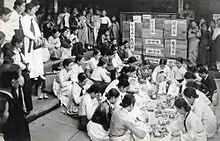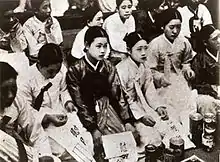


Comfort bag (慰問袋, imon-bukuro) was a gift packet prepared by civilians to be sent to Imperial Japanese Military soldiers for the purpose of encouraging them. The bag contains comfort articles (慰問品, imon-hin) not issued by the Japanese Military, such as toiletries, dried fruits, canned foods, and letters of encouragement. Bags were prepared by schoolgirls or local patriotic women's societies. These activities were also made in Korea, which was then under Japanese rule, to encourage Korean soldiers in the Imperial Japanese Military.[1][2][3]
Comfort Bags and Comfort Dolls
Comfort bags (慰問袋, imon-bukuro) were traditionally prepared by women in the territories that Japan occupied during World War II.[4] Among the items in the bags, the comfort doll became significant to many Japanese soldiers.[5] One account describes a soldier fighting in China holding onto a comfort doll, given to him by a young Japanese girl, until he was killed.[4] His fellow soldiers then preserved the doll and even redressed it with clothes created by that same young girl.[6] The soldier, Obayashi, had no family to send him letters or extra supplies, so he relied heavily on the government distributed comfort bags. The doll became incredibly important to him as it represented a mother or a little sister that he is missing from his real life.[7] Much like Obayashi, other soldiers also found comfort within the comfort dolls. They would give them names, dress them in pretty clothes, and treat them as objects of affection.[6] There are theories that the reason why comfort dolls were so popular was because of the isolation that the soldiers felt when they were fighting overseas on foreign territory. The dolls provided a reference of the feminine, promoting ideas of heterosexuality and served to remind the soldiers of the Japanese women back at home.[8]
Comfort Bags and Comfort Women
Comfort Bags were packed not only by Japanese women, but also by women in Japanese occupied territory.[9] These comfort women quickly came to serve a similar function to the dolls they made, because they offered a glimpse of the feminine for the soldiers fighting on the front lines. Similarly to the dolls and the comfort bags, the women were described as “imperial gifts” by the Japanese government, and were meant to serve as a reward for the men’s contributions in the war.[10] Over time, comfort women were regarded as an essential military resource, and were seen simply as materials rather than individuals.[11] Many were given Japanese names to replace their own, as it would be more comfortable for the soldiers to interact with women with Japanese names. They could be reminded of their lives at home, at the expense of the dehumanization of these women.[12] Comfort women were not seen as people, but rather, like the contents of a comfort bag, they are a resource meant to provide support for the troops and to keep their morale up during the war.[11]
However, there are also accounts of the soldiers treating the comfort women as objects of affection, much like their comfort dolls. Although many endured inhumane treatment at the hands of the Japanese army, there are also women who shared stories of being treated kindly by soldiers.[13] One woman’s accounts describe a young soldier who treated her more like a sibling than a girlfriend, stating that she reminded him of his sister back at home.[14] Similarly another account describes a Japanese soldier telling his wife back in Japan that he was romantically involved with a Korean comfort woman. Instead of reacting in anger, his wife was very supportive, and even sent them both gifts.[15] In this way, the soldiers not only saw comfort women as sex slaves, but rather, as a reminder of women back at home, whether that be wives and lovers or sisters and daughters.[16] Like comfort dolls, these comfort women served as a symbol of the feminine, and offered the soldiers a relief from the horrors of war by also enforcing the heterosexual norm and an opportunity to interact with women in a largely masculine setting.[17] They were not only there to alleviate physical needs, but acted as important pillars of emotional support in the cruel landscape of war.[16]
See also
References
- ↑ Niiya, Brian, ed. (1993). Japanese American History: An A-to-Z Reference from 1868 to the Present. VNR AG. p. 173. ISBN 0816026807.
- ↑ Hayashi, Brian Masaru (1995). For the Sake of Our Japanese Brethren: Assimilation, Nationalism, and Protestantism Among the Japanese of Los Angeles, 1895-1942. Stanford University Press. p. 104. ISBN 0804723745.
- ↑ Soh, C. Sarah (2008). The Comfort Women: Sexual Violence and Postcolonial Memory in Korea and Japan. University of Chicago Press. p. 135. ISBN 978-0226767772.
- 1 2 Schattschneider, Ellen (2005). "The Bloodstained Doll: Violence and the Gift in Wartime Japan". Journal of Japanese Studies. 31 (2): 329–356. ISSN 0095-6848. JSTOR 25064571.
- ↑ Schattschneider, Ellen (2005). "The Bloodstained Doll: Violence and the Gift in Wartime Japan". Journal of Japanese Studies. 31 (2): 330. ISSN 0095-6848. JSTOR 25064571.
- 1 2 Schattschneider, Ellen (2005). "The Bloodstained Doll: Violence and the Gift in Wartime Japan". Journal of Japanese Studies. 31 (2): 329–330. ISSN 0095-6848. JSTOR 25064571.
- ↑ Schattschneider, Ellen (2005). "The Bloodstained Doll: Violence and the Gift in Wartime Japan". Journal of Japanese Studies. 31 (2): 338–339. ISSN 0095-6848. JSTOR 25064571.
- ↑ Schattschneider, Ellen (2005). "The Bloodstained Doll: Violence and the Gift in Wartime Japan". Journal of Japanese Studies. 31 (2): 339–340. ISSN 0095-6848. JSTOR 25064571.
- ↑ Soh, Chunghee Sarah (2008). The comfort women : sexual violence and postcolonial memory in Korea and Japan. Chicago: University of Chicago Press. p. 135. ISBN 978-0-226-76776-5. OCLC 225875908.
- ↑ Soh, Chunghee Sarah (2008). The comfort women : sexual violence and postcolonial memory in Korea and Japan. Chicago: University of Chicago Press. pp. 30–32. ISBN 978-0-226-76776-5. OCLC 225875908.
- 1 2 Soh, Chunghee Sarah (2008). The comfort women : sexual violence and postcolonial memory in Korea and Japan. Chicago: University of Chicago Press. pp. 38–39. ISBN 978-0-226-76776-5. OCLC 225875908.
- ↑ Soh, Chunghee Sarah (2008). The comfort women : sexual violence and postcolonial memory in Korea and Japan. Chicago: University of Chicago Press. p. 39. ISBN 978-0-226-76776-5. OCLC 225875908.
- ↑ Min, Pyong Gap (2021). Korean "comfort women" : military brothels, brutality, and the redress movement. New Brunswick. pp. 117–124. ISBN 978-1-9788-1496-7. OCLC 1152481230.
{{cite book}}: CS1 maint: location missing publisher (link) - ↑ Min, Pyong Gap (2021). Korean "comfort women" : military brothels, brutality, and the redress movement. New Brunswick. pp. 120–121. ISBN 978-1-9788-1496-7. OCLC 1152481230.
{{cite book}}: CS1 maint: location missing publisher (link) - ↑ Min, Pyong Gap (2021). Korean "comfort women" : military brothels, brutality, and the redress movement. New Brunswick. p. 120. ISBN 978-1-9788-1496-7. OCLC 1152481230.
{{cite book}}: CS1 maint: location missing publisher (link) - 1 2 Min, Pyong Gap (2021). Korean "comfort women" : military brothels, brutality, and the redress movement. New Brunswick. p. 121. ISBN 978-1-9788-1496-7. OCLC 1152481230.
{{cite book}}: CS1 maint: location missing publisher (link) - ↑ Schattschneider, Ellen (2005). "The Bloodstained Doll: Violence and the Gift in Wartime Japan". Journal of Japanese Studies. 31 (2): 339–340. ISSN 0095-6848. JSTOR 25064571.